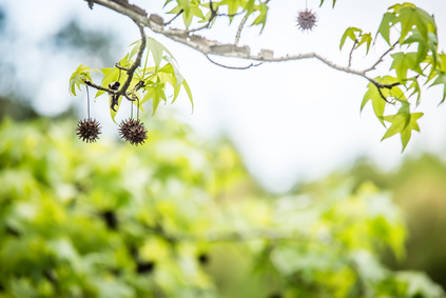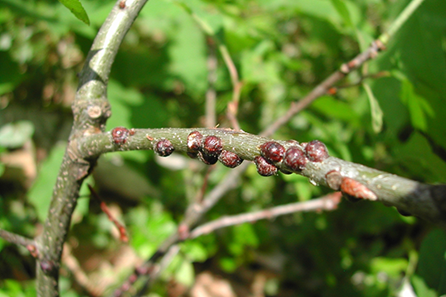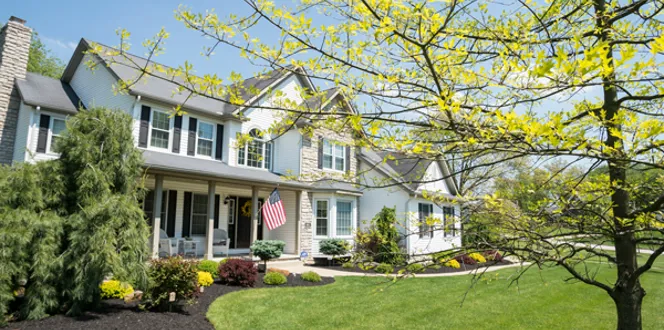Sometimes you plant a tree for the fall show it puts on each year, and the sweetgum puts on quite a spectacular display.
In the fall, the sweetgum tree’s leaves vary from maroon to vibrant ruby red and from pink to tangerine and yellow. What’s more, it draws butterflies and birds, like American goldfinches, red-winged blackbirds, chickadees, juncos, wrens, sparrows and cardinals – among others.
For larger home landscapes, the sweetgum can be a treat, providing shade in addition to autumn colors and wildlife retreats.
Let’s learn more about how to identify a sweetgum tree, its maintenance needs, and potential threats you can stay ahead of as you care for this beauty.
How To Identify A Sweetgum Tree
You might be wondering, “What does a sweetgum tree look like?”
The pyramidal shape that becomes more rounded with age, loves full sun. Let’s take a look at some of its specific identifiers.
Sweetgum Leaves

To correctly identify a sweetgum tree, start by looking for its large star-shaped, lobed leaves. Each leaf has five points with serrated or saw-toothed edges.
As far as color, the upper sides of sweetgum tree leaves are medium to dark green, while the undersides are pale green.
Sweetgum Bark
The sweetgum tree bark is light gray-brown in color with somewhat deep, rounded ridges.
The American sweetgum actually gets its name from the gummy sap that is found under its bark. It is golden in color and has a sweet odor.
Sweetgum Tree Balls

The sweetgum tree does produce spiky clusters that are balls of fruit filled with tiny seeds. In fact, squirrels and birds tend to dine on these.
But by mid-autumn, the sweetgum tree balls lose their seeds and die, and similar to leaves, they fall as the tree prepares for new growth.
Do sweetgum balls make a good mulch? These balls can make a decent, loose mulch that allows air and water to pass into the soil below but block sunlight from germinating weeds. The spiky mulch also helps keep animals away from your young plants.
To avoid these spiky balls plant a fruitless sweetgum tree that has similar characteristics to the regular tree but is a tidier alternative.
Sweetgum Tree Characteristics
Native to the Southeastern U.S. there are fifteen species of sweetgum trees. The tree was once popular in the making of adhesives, pharmaceuticals and soaps, but today people use its wood to make fine furniture and interiors.
Let’s look at more about how the tree grows.
- Grow zones: The American sweetgum tree prefers growing in U.S. hardiness zones 5 to 9.
- Bloom/Flowering: When do sweetgum trees bloom? March to May is the ideal time to see sweetgum blooms, which appear on male trees as large numbers of very small flowers gathered in clusters on thick stalks above branches.
- Height/spread: This tree is fairly large, growing to a height of 60 to 75 feet and a spread of 40 to 50 feet.
- Sunlight: Plant sweetgum trees in full sun, which is at least 6 hours of direct, unfiltered sun daily.
- Best time to prune: Prune sweetgum trees in late winter or early spring before new growth begins.
Potential Threats

Some people consider sweetgum tree balls to be messy or a problem, but you can still benefit from this species’ lovely fall color and shade.
While fairly simple to care for, there are some insects that you can watch out for on sweetgum trees.
Scale is one. These tiny insects can look similar to diseased bumps, but you’ll likely see the discolored leaves, bumpy branches, or oozing bark.
Fall webworms and tent caterpillars are other pests to watch out for on your sweetgum. You might find unsightly nests built between branches or skeletonized leaves.
When it comes to tree diseases, there are some cankers and fungal spot diseases that you might find bothering your sweetgum. Cankers can attack wounded or weakened trees, producing sunken areas on the bark that not only look unattractive but can also cause branch dieback and even death if allowed to go too far. A certified arborist will be able to help.
Cercospora is a fungal spot disease that produces dark brown spots on both sides of sweetgum tree leaves, and it can lead to leaf drop. Control this disease by calling your local arborist







